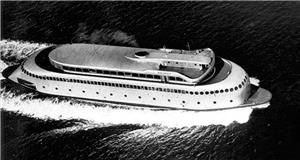On February 14, 1946, the ferry Kalakala begins using a radar set on its Seattle-Bainbridge Island run. It is the first-ever commercial use of radar on a ship anywhere in the world. This occurs on the day that a sizable 5.8 earthquake hits Puget Sound.
Can Do Anything But Fry Eggs
The Seattle Times was invited on-board to see the radar in action. A report by the paper’s Robert Mahaffay said:
“The ferry Kalakala’s radar set can do just about anything but fry eggs or talk seagull talk. After ten days of tinkering by experts, the set wound up and began pitching strikes today, to the pop-eyed amazement of those in the pilot house. The set, installed by the Raytheon Manufacturing Company of New York as a commercial-model experiment, is the first of its kind to be placed on any ship anywhere” (The Seattle Times).
C. H. Sterns, chief electrician for the Black Ball Ferry Lines company, which operated the Kalakala, said, “It really isn’t any more complicated than a radio. And it certainly is going to take any hit-and-miss element out of fog-running. Why, the other day we even picked up a floating log on it” (The Seattle Times).
You Can't Get Lost
Kalakala skipper Captain A. O. Rindal added:
“For running in the fog it’s an absolute boon. If all ships had it, marine accidents would become virtually non-existent. You know exactly where you are every second. You can’t get lost” (The Seattle Times).
The
Kalakala’s
radar set displayed water as black on its five-inch radius dial, with land masses, ships, buoys, and others objects displaying as white. A blue light swept around the dial and continually refreshed its picture as the radar’s antenna responded to the changing position of objects.
E. W. Peabody, marine superintendent for Black Ball Ferry Lines, said:
“It’s very good, and we hope eventually to have them on all the ferries. Right now, though, we can’t get them. What the instrument really is is a Navy model with commercial modifications” (The Seattle Times).

